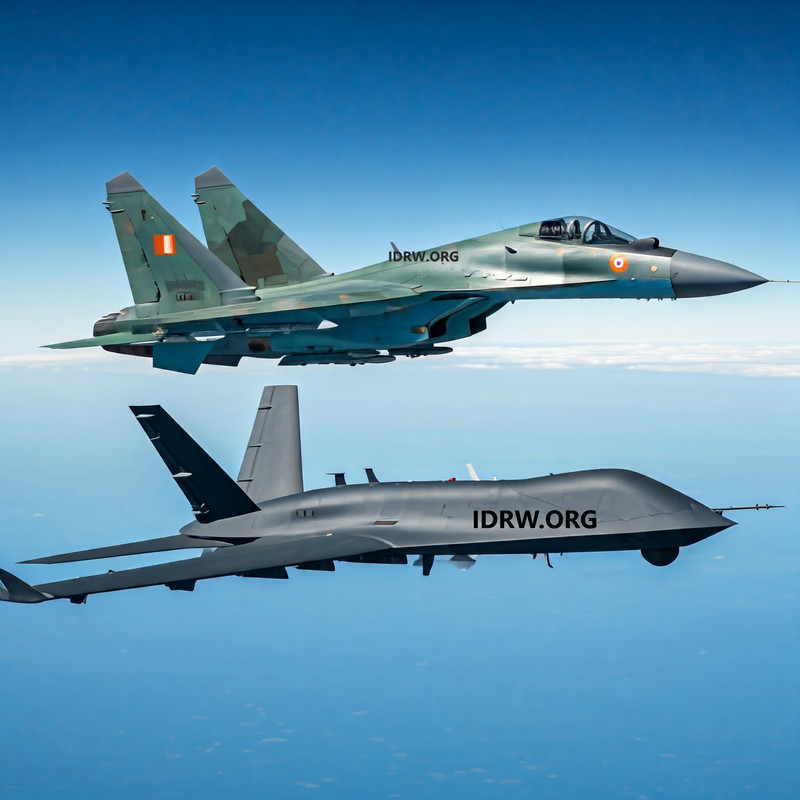SOURCE: AFI


The Indian Air Force (IAF) has long relied on the Sukhoi-30MKI as a workhorse in its fighter fleet, thanks to its multirole capabilities, impressive payload capacity, and combat range. With the upcoming Super Sukhoi upgrade program, the Sukhoi-30MKI is poised to become a cornerstone in India’s adoption of cutting-edge technologies, including Manned-Unmanned Teaming (MUM-T). Defence analyst Ranesh Rajan shared his insights with idrw.org, explaining why this aircraft will be an ideal platform for integrating MUM-T capabilities.
The Super Sukhoi upgrade promises to enhance the Sukhoi-30MKI’s radar, avionics, electronic warfare (EW) systems, and weapon-carrying capacity. Key upgrades include the integration of an Active Electronically Scanned Array (AESA) radar, new mission computers, and advanced sensors, which will significantly boost its situational awareness and combat performance.
According to Rajan, these enhancements make the Sukhoi-30MKI an ideal candidate for MUM-T, enabling seamless communication and coordination with unmanned aerial vehicles (UAVs) in complex battle scenarios.
The Sukhoi-30MKI boasts a 12-tonne payload capacity and a combat radius of over 1,500 kilometers, unmatched by most other aircraft in the IAF’s inventory. This allows it to carry both advanced sensors for reconnaissance and a mix of offensive and defensive weapons, making it a perfect mothership for unmanned assets.
“MUM-T operations require a platform capable of commanding multiple UAVs while maintaining a robust offensive and defensive capability. The Sukhoi-30MKI’s large airframe and payload capacity allow it to act as a control hub while staying combat-ready,” Rajan noted.
The AESA radar being installed in the Super Sukhoi upgrade will significantly improve the Sukhoi-30MKI’s ability to detect and track multiple targets, a critical capability for MUM-T operations. Additionally, the integration of advanced data-link systems will facilitate secure and high-speed communication with UAVs, enabling real-time information sharing and coordinated action.
“These upgrades are not just incremental; they represent a leap in capability. The ability to simultaneously manage multiple UAVs and perform its own combat role makes the Sukhoi-30MKI a force multiplier,” Rajan added.
MUM-T combines the strengths of manned aircraft, such as decision-making and adaptability, with the persistence, expendability, and versatility of UAVs. In a MUM-T setup, the Sukhoi-30MKI could command UAVs for tasks like reconnaissance, electronic warfare, or even strike missions, reducing risk to human pilots while increasing operational flexibility.
India’s development of autonomous UAVs like the CATS Warrior and DRDO’s Ghatak UCAV aligns perfectly with the IAF’s MUM-T ambitions. Rajan highlighted that the Sukhoi-30MKI’s two-person crew provides an advantage, with one pilot focusing on flying the aircraft and the other on managing UAV operations.
The Super Sukhoi upgrade ensures the IAF gets a modern, technologically advanced aircraft without the expense of acquiring entirely new platforms. This makes it a cost-effective solution for implementing MUM-T capabilities across a proven platform, leveraging the IAF’s extensive operational experience with the Sukhoi-30MKI.
With MUM-T being a cornerstone of next-generation warfare, the upgraded Sukhoi-30MKI will position the IAF as a technologically advanced force. The platform’s ability to control multiple unmanned assets will enhance its effectiveness in a range of scenarios, from high-intensity conflicts to counter-insurgency operations.
Rajan concluded, “The Sukhoi-30MKI’s versatility, combined with the Super Sukhoi upgrades, will make it the ideal platform for MUM-T. It’s a logical, forward-thinking step that prepares the IAF for the challenges of modern air warfare.”